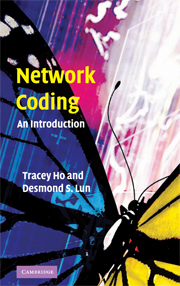1 - Introduction
Published online by Cambridge University Press: 06 July 2010
Summary
Network coding, as a field of study, is young. It was only in 2000 that the seminal paper by Ahlswede, Cai, Li, and Yeung, which is generally attributed with the “birth” of network coding, was published. As such, network coding, like many young fields, is characterized by some degree of confusion, of both excitement about its possibilities and skepticism about its potential. Clarifying this confusion is one of the principal aims of this book. Thus, we begin soberly, with a definition of network coding.
WHAT IS NETWORK CODING?
Defining network coding is not straightforward. There are several definitions that can be and have been used.
In their seminal paper, Ahlswede, Cai, Li, and Yeung say that they “refer to coding at a node in a network as network coding,” where, by coding, they mean an arbitrary, causal mapping from inputs to outputs. This is the most general definition of network coding. But it does not distinguish the study of network coding from network, or multiterminal, information theory — a much older field with a wealth of difficult open problems. Since we do not wish to devote this book to network information theory (good coverage of network information theory already exists, for example, in [27, Chapter 14]), we seek to go further with our definition.
- Type
- Chapter
- Information
- Network CodingAn Introduction, pp. 1 - 12Publisher: Cambridge University PressPrint publication year: 2008
- 5
- Cited by



